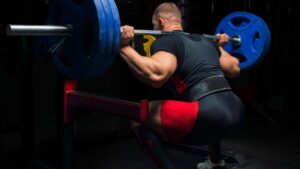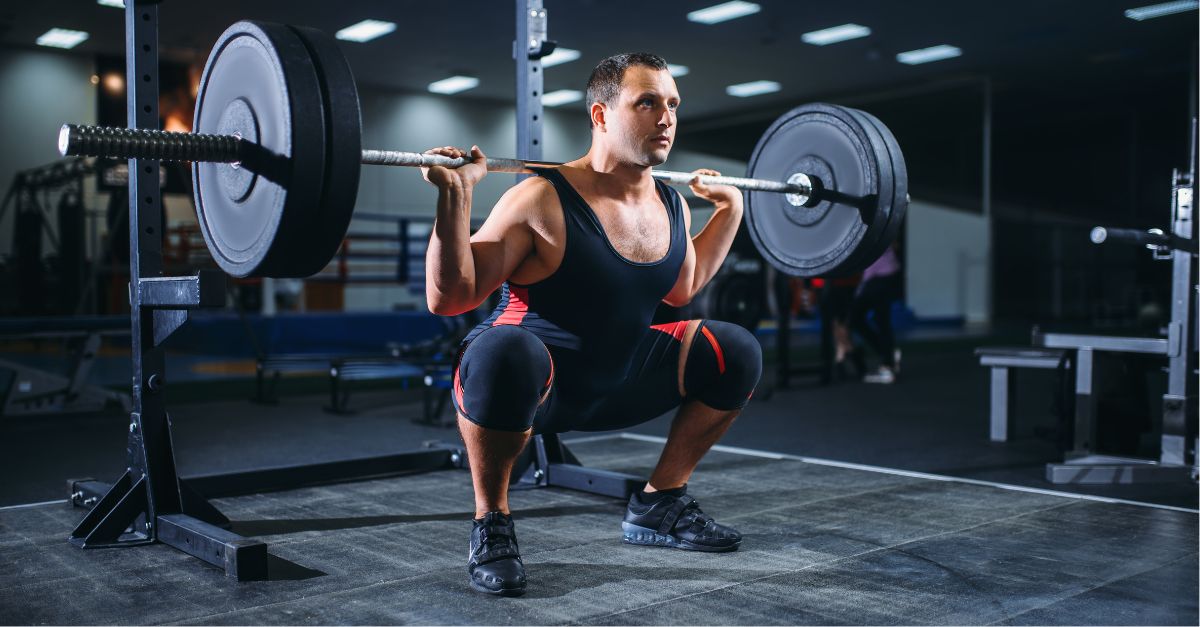Hey there, fellow fitness enthusiasts! So, you’ve decided to take your strength training to the next level and attempt a 140 kg back squat kudos to you! But, before you dive into the world of heavy lifting, there’s a crucial question to answer: What breathing technique should you use?
In this blog post, we’re going to break down the ins and outs of the ideal breathing method for a 140 kg back squat.
Get ready to boost your squat game and learn how to breathe like a pro during those heavy lifts.
Understanding the optimal breath technique For a 140 kg back squat?
When performing a 140 kg back squat or any heavy resistance exercise, proper breathing technique is crucial to maintain stability and support your efforts.
The most commonly recommended breathing technique for a back squat, especially at such a high weight, is the Valsalva maneuver.
Here’s how it works:
Preparation: Stand with the barbell on your upper back, resting just below your neck and across your shoulders.
Make sure your feet are shoulder-width apart, with your toes pointing slightly outward. Grasp the barbell firmly with your hands, keeping your elbows down and back to create a stable shelf for the bar.
Inhalation: Before you start the descent, take a deep breath in through your nose and fill your lungs as much as possible. This breath should be deep into your diaphragm and not just a shallow chest breath. This is the air you’ll use to create intra-abdominal pressure.
The Descent: As you begin to squat down, focus on keeping your chest up and your core tight. You want to maintain a strong and stable core throughout the movement.
Exhalation: Do not exhale as you descend. Instead, hold your breath and maintain the intra-abdominal pressure created by the deep breath you took before starting the descent.
Ascent: Once you’ve reached the bottom of your squat (usually when your thighs are parallel to the ground or slightly below), begin to push the weight back up. Continue to hold your breath and maintain intra-abdominal pressure as you lift.
Breathing Break: It’s essential to maintain this breath hold until you’ve completed the ascent. Once you’ve returned to a standing position, you can release the breath.
Recovery Breath: After the repetition is complete, take a moment to recover and catch your breath. Then, repeat the process for your next repetition or set.
The Valsalva maneuver is beneficial for heavy lifts because it stabilizes your spine and core, helping you generate more power and protect your back.
However, it’s essential to use this technique with caution and ensure you have proper form and supervision, especially when dealing with extremely heavy weights.
Always prioritize safety and consider working with a qualified fitness professional to ensure you’re using the correct breathing technique for your specific circumstances.
Further Explanations.
Let’s dive deeper and elaborate further on all the points mentioned.
Firstly let’s delve deeper into the key aspects of the preparation and inhalation phases when performing a back squat with a focus on proper breathing technique:
Preparation:
Barbell Placement: Begin by positioning the barbell on your upper back, specifically on the trapezius muscles, just below the base of your neck.
The bar should rest on a “shelf” created by retracting your scapulae (shoulder blades). This shelf helps distribute the weight evenly and prevents the bar from rolling or sliding during the squat.

Foot Position: Stand with your feet shoulder-width apart. This width provides a stable base for the squat.
Your toes should be angled slightly outward, typically at about 15 to 30 degrees. This foot placement helps maintain balance and accommodates your hip and knee joint movement during the squat.
Grip: Grasp the barbell firmly with your hands. Your grip should be slightly wider than shoulder-width, and your palms should face forward.
The goal is to create a sturdy platform for the bar to rest on your upper back. Keep your elbows pointing downward and slightly back to establish this shelf for the bar.
Inhalation:
Deep Breath: Before initiating the squat descent, take a deep breath in through your nose. This breath should be deep and fill your lungs completely, not just a shallow breath into your chest. Imagine filling your abdomen, sides, and lower back with air.
Diaphragmatic Breathing: Focus on breathing into your diaphragm, a dome-shaped muscle below your ribcage that separates your chest from your abdomen.
As you inhale, your diaphragm contracts and moves downward, creating space for your lungs to expand. This type of breathing maximizes your lung capacity and helps create intra-abdominal pressure.
Intra-Abdominal Pressure: The air you inhale is used to create intra-abdominal pressure, which is like inflating a balloon inside your core. This pressure stabilizes your spine and core during the squat, providing support and protection for your lower back.
To better visualize diaphragmatic breathing, you can place your hand on your abdomen while inhaling. Your abdomen should expand outward as you take a deep breath.
This is a key component of the Valsalva maneuver and ensures that you’re filling your lungs properly to support the heavy squat.
Remember that mastering these fundamentals of barbell placement and deep, diaphragmatic breathing is essential for safely and effectively performing heavy back squats. Practice with lighter weights initially to perfect your form before progressing to heavier loads.

Continuing with the explanation of the descent and exhalation phases of the back squat:
The Descent:
Maintaining Posture: As you start to squat down, it’s crucial to maintain proper posture. Keep your chest up and your back straight.
This helps prevent your upper body from collapsing forward, which can place excessive strain on your lower back and compromise your form.
Core Engagement: Throughout the descent, your core muscles should remain tight and engaged. Imagine bracing your core as if you were about to receive a punch in the stomach.
This core stability is vital for supporting your spine and maintaining balance as you lower your body.
Hip and Knee Movement: As you descend, your hips should shift backward while your knees bend. This movement pattern is often described as “sitting back” into the squat.
It ensures that your knees do not extend too far beyond your toes, which can strain the knee joint.
Depth: The depth of your squat can vary depending on your flexibility, mobility, and training goals. In general, aim to lower your body until your thighs are at least parallel to the ground.
Some individuals may achieve a deeper squat, known as “ass-to-grass,” where the hips go below knee level. However, depth should not come at the expense of form or comfort.
Exhalation:
Hold Your Breath: During the descent phase of the squat, it’s essential to hold your breath and maintain the intra-abdominal pressure that you created with the deep inhalation before starting the descent.
The Role of Breath Holding: By holding your breath, you’re essentially locking your core in a stable and rigid position. This intra-abdominal pressure acts as a natural weight belt, providing support to your spine and reducing the risk of injury.
Exhale at the Top: You should not exhale as you descend, even if the effort feels intense. Continue to hold your breath until you’ve completed the ascent and returned to a standing position. It’s at this point that you can safely exhale and take a recovery breath.
The key takeaway here is that maintaining a strong and stable core, along with holding your breath during the descent, contributes to your safety and performance during heavy back squats.
However, it’s crucial to emphasize that breath holding should only be done for short durations, such as during heavy lifting, and not for extended periods to avoid potential health risks.
Always prioritize safety, proper form, and gradual progression when incorporating heavy squats into your training routine.
let’s dive deeper into the ascent phase, the importance of maintaining breath hold, and the subsequent recovery breath during heavy back squats:
Ascent:
Pushing Back Up: As you reach the bottom of your squat, which is typically when your thighs are parallel to the ground or slightly below, it’s time to initiate the ascent. This phase requires a strong and controlled effort to push the weight back up to the starting position.
Continued Breath Hold: Throughout the entire ascent, you should maintain the breath hold and intra-abdominal pressure created during the inhalation phase. This is critical for several reasons:
Spinal Stability: Holding your breath and maintaining intra-abdominal pressure stabilizes your spine. It acts as a natural weight belt, reducing the risk of spinal injury during heavy lifting.
Core Support: The pressure supports your core muscles, helping you generate power and maintain balance during the upward phase of the squat.
Efficiency: Breath holding also enhances the efficiency of the lift. It allows you to channel your energy into lifting the weight rather than dissipating it through exhalation.
Breathing Break:
Release at the Top: It’s essential to continue holding your breath until you’ve completed the ascent, and the barbell is back at the top position, with your knees and hips fully extended. This is the most stable and controlled part of the movement.
Controlled Release: Once you’re standing upright and in control of the weight, you can release your breath. Exhale gently but avoid forcefully expelling the air. The controlled release helps prevent dizziness or light-headedness that can sometimes occur when holding your breath during heavy lifting.
Recovery Breath:
Post-Set Recovery: After completing a repetition or set of back squats, it’s crucial to take a moment to recover and catch your breath. This brief pause allows your body to reset and ensures you don’t become overly fatigued.
Deep Inhale: For the recovery breath, take a deep inhalation through your nose, filling your lungs as you did before starting the squat. This breath helps replenish oxygen levels and prepares you for the next repetition or set.
Rehydrate and Rest: During your recovery breath, you can also take a sip of water if needed to stay hydrated. Additionally, use this time to evaluate your form and mental focus before continuing with your squats.
Incorporating these elements of the ascent, breath hold, and recovery breath into your back squat routine is vital for maintaining safety, stability, and performance during heavy lifting.
Remember that while breath holding is effective during maximal lifts, it should be used judiciously and not for extended periods, as it can temporarily increase blood pressure.
Always prioritize proper form, gradual progression, and personal safety when engaging in resistance training exercises like back squats.
A tabular on this topic here
Here’s a tabular breakdown of the breathing technique for a 140 kg back squat:
| Squat Phase | Breathing Technique |
|---|---|
| Preparation | – Stand with barbell on upper back. |
| – Feet shoulder-width apart, toes slightly outward. | |
| – Firm grip on the bar, elbows down and back. | |
| Inhalation | – Take a deep breath in through the nose, filling lungs fully. |
| – Focus on diaphragmatic breathing for intra-abdominal pressure. | |
| The Descent | – Keep chest up, core tight. |
| – Hips back, knees bend to squat down. | |
| – Maintain the breath hold and intra-abdominal pressure. | |
| Ascent | – Push the weight back up. |
| – Continue to hold breath and intra-abdominal pressure. | |
| Breathing Break | – Release breath once fully upright at the top. |
| Recovery Breath | – Take a deep recovery breath through the nose. |
| – Rehydrate and assess form before the next repetition. |
This table outlines the specific breathing technique for each phase of a 140 kg back squat, emphasizing the importance of breath control and intra-abdominal pressure to maintain stability and support during this challenging exercise.
My concise conclusion here.
For a 140 kg back squat, it’s essential to employ the Valsalva maneuver for proper breath control.
This technique involves taking a deep breath before descending, holding it throughout the descent and ascent, and only exhaling once fully upright at the top of the squat.
This approach helps maintain intra-abdominal pressure, stabilizes the spine, and ensures safety and effectiveness during the lift.

Hey there, it’s Mike Rrsq, the Editor-in-Chief over at Jsquat.com, and I’m absolutely obsessed with all things squat fitness! I’ve been lucky enough to get some serious recognition for my work in this field. With a solid background in the fitness and wellness industry, I’ve been there right from the get-go, helping shape this website into what it is today.
You see, I’m not just the boss around here; I’m also a passionate contributor. I love sharing my insights through my articles, and trust me, they’re not your run-of-the-mill stuff. Each piece I write is a labor of love, filled with my expertise and real-world experience in the fitness universe. So, if you’re into fitness and looking for some inspiration, you’re in the right place!

